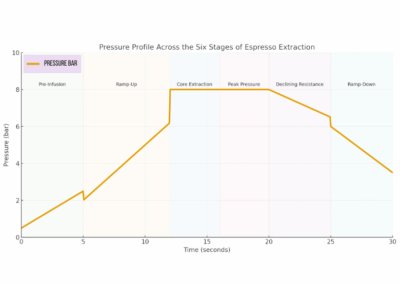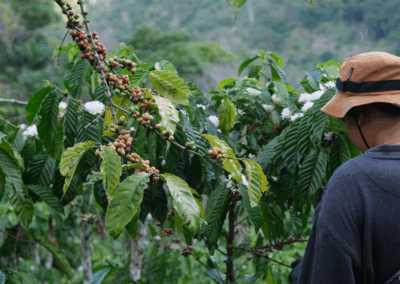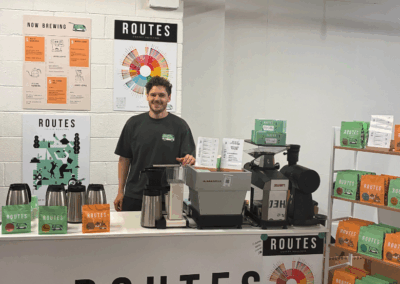A Deep Dive Into Pressure Profiling: How Modern Espresso Machines Let Us Shape Flavour
Pressure profiling once lived on the fringes of espresso theory. It was a topic for engineers, modders, and forum die-hards. Fast forward to today, and it has become one of the most powerful tools for baristas and roasters looking to unlock nuance, sweetness, clarity, and structure in their espresso.
But pressure profiling isn’t magic, and it isn’t a gimmick.
Used well, it’s a way to shape flavour intentionally.
Used badly, it adds complexity without reward.
This guide breaks down pressure profiling in a grounded, Routes Coffee way:
practical, sensory-led, and rooted in real extraction behaviour.
The Fundamentals: Why Pressure Exists at All
Espresso is built on a relationship between:
-
Fine grind size
-
A compacted, even puck
-
High pressure
-
Resistance from the coffee bed
When water meets a densely packed puck of fine grounds, resistance builds.
This resistance is what allows pressure to rise and pressure is what differentiates espresso from every other brewing method.
Pressure creates:
-
crema
-
viscosity
-
layers of dissolved compounds
-
density of flavour
Pressure profiling gives us the ability to manipulate how and when that resistance builds, and how water moves through the puck over time.
Modern Machines Make Profiling Accessible
Where profiling once required hacked equipment and external pumps, modern machines bring control into the hands of any serious barista.
Machines such as:
-
La Marzocco Strada
-
Synesso MVP Hydra
-
Decent Espresso (DE1)
-
El Rocio Manus S
…allow baristas to shape both pressure curves and flow curves.
These machines give control over:
-
pre-infusion pressure
-
ramp speed
-
peak pressure
-
flow rate (water debit)
-
ramp-down behaviour
-
real-time adjustments during extraction
This shift isn’t small, it changes the way espresso is designed.
Understanding Flow: The Missing Half of the Conversation
If pressure is the force applied to the puck, flow is how fast water actually moves through it.
Flow is influenced by:
-
grind size
-
puck density
-
roast density
-
how much material has dissolved
-
applied pressure
-
resistance within the puck
As extraction progresses:
-
The puck starts dense.
-
Resistance is high.
-
Flow starts slow.
-
Solubles dissolve.
-
The puck opens.
-
Flow increases naturally.
Pressure profiling lets you respond to this change.
Slowing flow in early extraction emphasises sweetness and texture.
Increasing flow later can emphasise clarity and aromatics.
This dynamic relationship between pressure and flow is where profiling becomes artful.
Roast Density: Why Light and Dark Extract So Differently
Roast level changes the internal structure of the bean.
Light roasts
-
Higher density
-
Tighter internal structure
-
More intact acids, sugars, and aromatic compounds
-
Resist water
-
Require longer contact time or higher ratios
Dark roasts
-
Lower density
-
More open cellular structure
-
Fewer intact acids and sugars
-
Extract faster
-
Require lower ratios to avoid bitterness
Understanding roast density allows you to choose the right pressure and flow strategy, not just the right recipe.
Brew Ratios: A Starting Point, Not the Final Word
Classic espresso often follows a 1:2 ratio. But when profiling, ratios become flexible tools.
-
1:1.5 → darker roasts, traditional body
-
1:2 → balanced and familiar
-
1:2.5 – 1:3 → lighter roasts, clarity-driven shots
-
Turbo shots (1:3+ fast-flow) → juicy and high-clarity extractions
Ratios tell you where you’re going but Pressure and flow determine how you get there.
The Six Stages of a Profiled Extraction
Pressure profiling isn’t six steps you must follow. It’s a way to understand the behaviour of the puck so you can guide flavour.
1. Pre-Infusion (0–3 bar)
The goal: saturate evenly.
Benefits:
-
reduces channeling
-
enhances aromatic, fruit-forward notes
-
increases clarity
Short pre-infusion → more body
Longer pre-infusion → more brightness
2. Ramp-Up (3–6 bar)
The puck “activation” stage of the puck
A slower ramp:
-
stabilises the puck
-
encourages sweetness
-
reduces harshness
A faster ramp:
-
builds body
-
produces classic espresso structure
3. Core Extraction
You will find this is where caramel, nuts, chocolate, and mid-body flavours extract. Letting this phase breathe builds sweetness and roundness.
4. Peak Pressure (7–10 bar)
The hallmark of classic espresso.
Higher pressure:
-
increases body
-
intensifies complexity
-
speeds up flow
How long you hold peak depends on:
-
your pre-infusion
-
your grind size
-
how the puck is opening
5. Declining Resistance (flow increases naturally)
As the puck dissolves and opens, flow accelerates.
Profiling here lets you emphasise:
-
more clarity (higher flow)
-
more syrupiness (slower flow)
This is where espresso “unfolds.”
6. Ramp-Down / Taper Finish
Lowering pressure towards the end prevents:
-
bitterness
-
hollow aftertastes
-
over-extraction
It softens the finish and preserves clarity.
How Pressure Profiling Changes Flavour
More:
sweetness
-
slower ramp
-
lower initial pressure
-
extended core extraction
body
-
faster ramp
-
higher peak pressure
-
shorter ratio
clarity
-
longer pre-infusion
-
higher brew ratios
-
increased flow towards the end
balance
-
smooth pressure curve
-
controlled flow rate
-
attention to how the puck is dissolving
The Routes Perspective
Pressure profiling is not about making espresso more complicated. It’s about:
-
reading the extraction in real time
-
responding to how the puck behaves
-
understanding the relationship between pressure, flow, and flavour
-
designing espresso deliberately, not by recipe alone
Modern machines give us the tools.
Experimentation gives us the insight.
If you adjust your grind, revisit your ratios, and explore different curves with intention, pressure profiling becomes one of the most rewarding ways to craft exceptional espresso.








0 Comments